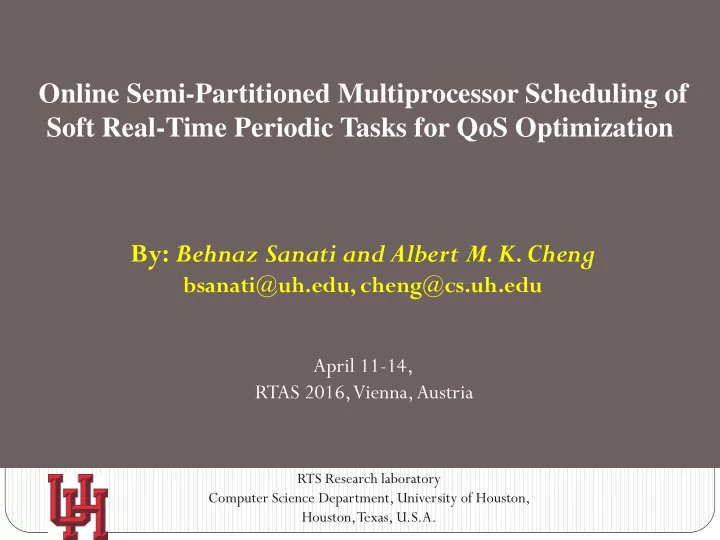

Online Semi-Partitioned Multiprocessor Scheduling of Soft Real-Time Periodic Tasks for QoS Optimization By: Behnaz Sanati and Albert M. K. Cheng bsanati@uh.edu, cheng@cs.uh.edu April 11-14, 2016 April 11-14, RTAS 2016, Vienna, Austria RTS Research laboratory Computer Science Department, University of Houston, Houston, Texas, U.S.A.
Introduction The Problem / Motivation Maximizing the benefit gained by soft real-time tasks in many applications is highly needed to provide an acceptable QoS Existing multiprocessor scheduling policies are mostly proposed for minimizing tardiness, and relatively very few studies on benefit- maximization Objective Providing an appropriate strategy for better QoS in highly loaded soft real-time multiprocessor systems with periodic tasks, by maximizing total gained benefit while minimizing tardiness, using approximation algorithms in semi-partitioning of the tasks at job-boundaries 4/11/2016 1:55 AM 2
Examples of Applications Online (and mobile) banking Multimedia applications Image and speech processing Robot control/navigation systems Medical decision making Body-sensor networks Medical monitoring systems Cloud computing, and IoT By Y.Gil, W.Wu and J. Lee 4/11/2016 1:55 AM 3
Task Model Soft real-time task sets Periodic tasks Independent in execution (No precedence constraints among them) Preemption is allowed Synchronous and/or Asynchronous Each task come with its period, WCET and benefit density function 4/11/2016 1:55 AM 4
System Model m identical processors Three storage areas for each processor: 1. Pool: for waiting jobs of any tasks (instead of a shared pool) 2. Stack: for the scheduled jobs (preempted or running) 3. Garbage collection: for the jobs that miss their deadlines and gain no benefit Software Architecture of the System for the system 4/11/2016 1:55 AM 5
Methodology (1 of 2) – Hybrid Model 4/11/2016 1:55 AM 6
Methodology (2 of 2) – Hybrid Model 4/11/2016 1:55 AM 7
Objective Functions and Solutions . Benefit Maximization The main goal in a benefit-aware, soft real-time system To gain maximum total value or benefit for the system by the jobs that complete their execution An approximate solution due to multiprocessor scheduling being an NP hard problem Reducing Tardiness Semi-partitioning approach (Migration at job-boundary) Overhead Reduction Reducing Number of Preemptions Limiting Migrations 4/11/2016 1:55 AM 8
Summary of Advantages toward QoS Optimization more conservative CPU cycles consumption (less idle time) Reduces the makespan without compromising on benefit maximization Increases the total benefit gained, specially on systems with higher work load, by Applicable to broader scope of tasks models , i.e. synchronous and/or asynchronous No off-line phase , and no limit on the number of processors for migrating jobs of each task (unlike other semi-partitioning techniques) The NP hard problem of multiprocessor scheduling is reduced into uniprocessor scheduling problem by partitioning the tasks at their arrival time (no dualization is needed as in RUN) 4/11/2016 1:55 AM 9
Thank You Questions or Comments? 4/11/2016 1:55 AM 10
Recommend
More recommend